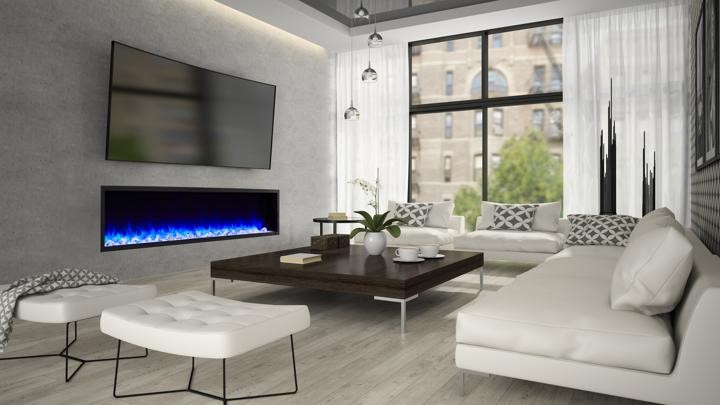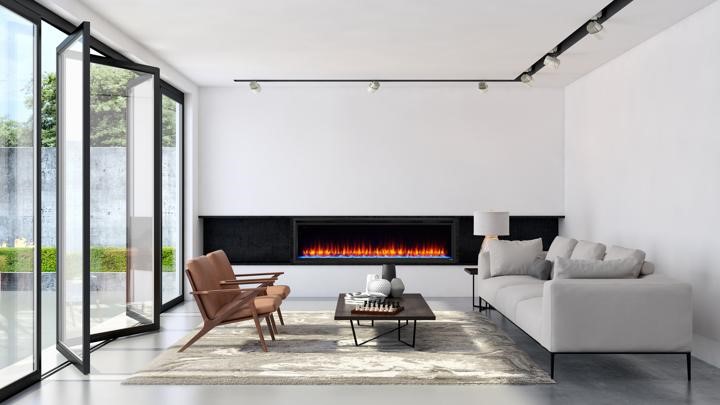Electric Fireplace Basics
More than a century after the first electric fireplace was built in 1912, these economical, low-maintenance hearth solutions are as popular as ever. As of January 2020, the North American electric fireplace market was about $900 million, with approximately 2 million electric fireplaces shipped. Sales of electric fireplaces are the single largest hearth product, more than double the total number of all wood, gas, pellet stoves and other fireplace sales in the continent.

Why Electric Fireplaces Are a Great Option
So, why are electric fireplaces so sought after?
A large part of the appeal is that they are extremely simple to install and easy to use.
“Ultimately, electric fireplaces are an attractive solution for customers because they don't have to have gas lines or venting they don't take up as big a footprint from a construction standpoint.
Does an Electric Fireplace Look Authentic?
For those looking for the standard old-school masonry fireplace style, most electric fireplaces, won’t fit the bill. (However, a built-in electric fireplace can feature a masonry-style interior.) By nature of the way they function—hidden coils create warmth while LED lights create the illusion of a flame.
Like wood-burning and gas fireplaces, electric hearths often feature appearance-enhancing options and decorative items such as trim and upgrade kits for the fireside experience you want.

How Do Electric Fireplaces Work?
Electric fireplaces supply light and heat just like a gas- or wood-fueled fireplace, however, they are unique in that that glow and warmth is created without an actual flame.
Do Electric Fireplaces Generate Heat?
The heat in an electric fireplace is about 5,000 BTU per hour, on par with a standard space heater and is generated from an auxiliary heater that is built into a separate area in the appliance that isn’t accessible to touch.
Types of Electric Hearth Products
It can be confusing to navigate all the styles and types of electric hearth products, and differing terminology among manufacturers and retailers can add to the confusion. Further complicating matters is that fireplace models, such as the Allusion, can be mounted several different ways, while others may only have one installation option.
With the exception of electric log sets (which are standalone units) most electric hearth products—much like gas fireplaces—include customizable options such as a hand-painted ceramic log set, ember bed media and colored flame.
Generally speaking, electric hearth products fit into these categories:
- Built-in electric fireplace: A fireplace that is completely finished into a wall. While some in the hearth industry refer to any recessed fireplace as a “built-in,” a true built-in fireplace cannot be removed without taking some of the wall down. Homeowners can choose to finish the hearth with surrounds and/or a mantel to make it look even more built-in. It will be hardwired to electric through the back of the unit.
- Recessed electric fireplace: A fireplace that is slid into a wall, either fully or partially recessed, after the wall is finished. It can be removed and relocated if desired by detaching it from the studs (but will require some patching on the wall that it is removed from). Either type will typically be hardwired through the back of the unit.
- Partially recessed: This type of fireplace is typically mounted into a 2 x 4 framed wall. Since the fireplace is slightly deeper than 4 inches, it will protrude a couple inches into the room.
- Fully recessed: A fireplace that is recessed flush in the wall for the cleanest possible appearance with no protrusion.
- Wall-mounted electric fireplace: A fireplace that is mounted to a fully finished wall much like a television would be, rather than slid into the wall. The wall behind the unit is left intact and the fireplace is plugged into a nearby outlet.
- Electric fireplace insert: These removable units are designed to convert existing wood-burning fireplaces into electric hearths. The electric insert slides right into the existing fireplace; a low-profile surround is used to cover any gaps between the fireplace insert and the existing fireplace. An insert often includes the components described above, such as a log set or ember bed media. It also can be hardwired through the back of the unit or plugged into a nearby outlet in the front.
- Electric log set: An arrangement of pre-fabricated "logs" that simply set inside an existing wood-burning fireplace, plug into an outlet and provide glow and a flame effect.
Key Benefits of Electric Fireplaces
Some of the most appealing benefits of electric fireplaces are what’s not required to have one. Since there is no need for a chimney, gas line, venting, costly maintenance or remodeling, they are quite versatile and can go just about anywhere in a home where there’s electricity available.
Another advantage is that an electric fireplace won’t take up a lot of floor space. Whereas a gas hearth can protrude about two feet into a room, an electric model will protrude a few inches at most, even if it’s mounted on the wall.
They’re also affordable. Even a high-end electric fireplace model such as the Scion starts at just over $1,600, with LED multicolored firebed lighting and other add-on options to update your living room, bedroom, home office or gathering space. Budget-friendly electric fireplaces such as a wall-mount style start closer to $500, making an electric fireplace a cost-effective way to upgrade just about any room in your home with little effort and virtually no maintenance. There are electric fireplace options for just about any budget, décor style, or home style, size or layout.

Electric fireplaces are incredibly versatile and can be installed in any home that has electricity—in fact, they can be installed in or on nearly any wall. Some home types lend themselves especially well to this technology.
- Townhomes, apartments, condos or other multifamily dwellings where there may be restrictions on fireplaces (or limited access to venting for a gas hearth)
- Anywhere where gas hookups are unavailable
- Areas that do not allow for venting, and where vent-less gas fireplaces are not allowed
- Areas where gas or wood-burning fireplaces are heavily restricted or not preferred
- Smaller homes or rooms that only need supplemental heat
- Homes where the fireplace will mostly be used for ambiance, or will be used infrequently
- Homes that have a dated, drafty or unusable wood-burning fireplace that could be converted to electric with an insert
- Homes with existing wood-burning fireplace where the chimney is unsafe or unusable
- Home or public and community gathering spaces where a real flame is not desired
Would you like to speak to a sales associate? Contact us at (203) 426-1230.
We are happy to answer any of your questions.



